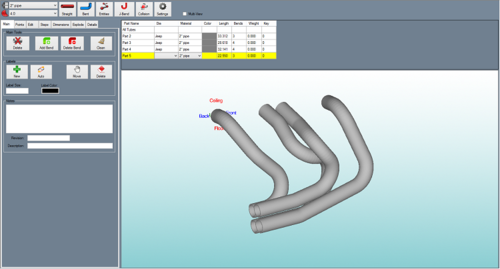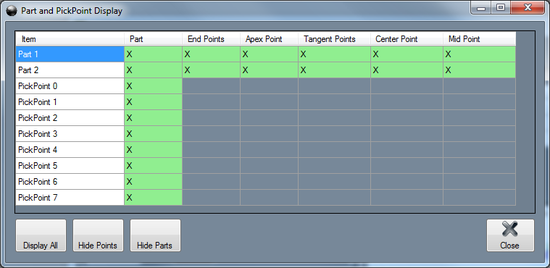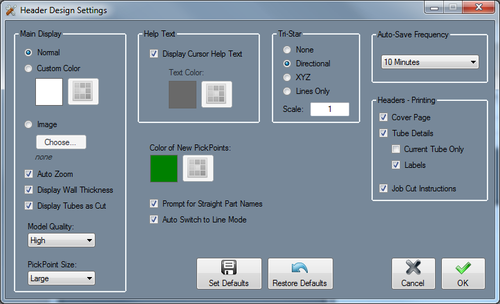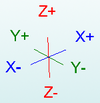Difference between revisions of "Header Design"
| Line 113: | Line 113: | ||
'''Auto-Save Frequency:''' The time interval between the automatic saves can be adjusted using this menu. | '''Auto-Save Frequency:''' The time interval between the automatic saves can be adjusted using this menu. | ||
| + | |||
'''Headers - Printing''' | '''Headers - Printing''' | ||
| − | '''Set Defaults:''' | + | :*'''Cover Page: |
| + | |||
| + | :*'''Tube Details:''' | ||
| + | |||
| + | :*'''Current Tube Only:''' | ||
| + | |||
| + | :*'''Labels:''' | ||
| + | |||
| + | :*'''Job Cut Instructions:''' | ||
| + | |||
| + | |||
| + | '''Set Defaults:''' Click the '''Set Defaults''' button [[File:set_default.png]] to use these settings as the defaults for future header designs. | ||
| − | '''Restore Defaults:''' | + | '''Restore Defaults:''' Click the '''Restore Defaults''' button [[File:restore_defaults.png]] to reset all the settings to the default selections. |
Revision as of 14:57, 11 June 2014
Bend-Tech 7x Wiki :: Header Design
The header design interface allows header tubes to be created and edited.
To open a new header design:
1.) Go to the File menu, select New -> Header.
2.) Click the New Assembly icon ![]() at the top of the window.
at the top of the window.
...OR
3.) Select the Header Design option from the Task Menu that appears when the software starts up, when all designs are closed, or through the view menu.
Tabs
A majority of the header design features and functions are located in the tabbed section on the right hand side of the window. To find information about how to use these features, see the links below.
| Main | Points | Edit | Steps | Dimensions | Explode | Details |
Header Menu
h3>Material</h3>
![]() In the material menu, the material for the parts in the header can be selected. To select a material, click the drop down menu and choose a material from the list. This material can be changed for each individual part later, this is just the material that is initially applied to new parts. Tube/pipe materials are defined in the Tube/Pipe Library.
In the material menu, the material for the parts in the header can be selected. To select a material, click the drop down menu and choose a material from the list. This material can be changed for each individual part later, this is just the material that is initially applied to new parts. Tube/pipe materials are defined in the Tube/Pipe Library.
Die
![]() In the die menu, the die used to bend the parts in the header design can be selected. To select a die, click the drop down menu and choose a die from the list. This can be changed for each individual part later, this is just the die that is initially applied to new parts. Dies are defined in the Die Library.
In the die menu, the die used to bend the parts in the header design can be selected. To select a die, click the drop down menu and choose a die from the list. This can be changed for each individual part later, this is just the die that is initially applied to new parts. Dies are defined in the Die Library.
Straight
To create a straight tube between two PickPoints, click the Straight button  and click any two PickPoints or Auto points (points that are automatically generated along parts, such as mid points, apex point, or start and end of bend points ) in the display window.
and click any two PickPoints or Auto points (points that are automatically generated along parts, such as mid points, apex point, or start and end of bend points ) in the display window.
Bent
To create a new bent part, click the Bent button.  To design the part, you must select the start point and the location of each bend, and the end point of the part.
To design the part, you must select the start point and the location of each bend, and the end point of the part.
Entities
The Entities tool controls which parts and points are displayed in the header. Click the Entities button  to open up this menu. Each row will represent straight part, bent part, and PickPoint. To hide a certain feature, click in the green box to remove the X. To have all features shown, click Display All button.
to open up this menu. Each row will represent straight part, bent part, and PickPoint. To hide a certain feature, click in the green box to remove the X. To have all features shown, click Display All button. ![]() To hide all PickPoints, click the Hide Points
To hide all PickPoints, click the Hide Points ![]() button. To hide all parts, click the Hide Parts button.
button. To hide all parts, click the Hide Parts button. ![]()
J-Bend
Collision
Settings
These settings are used to control the display and general options within the current header design.
Main Display
The main display settings control the part display and part model appears in the header interface. The background of the main display can be shown.
- Background: Select the Normal option for the part display background to be shown with the normal blue to white gradient. Select the Custom Color option to choose a custom solid color. Select the Image option to select an image file to display as the background.
- Auto Zoom: Check this option to automatically zoom all the way in on the current view of the 3D part display and fit it to the display frame.
- Display Wall Thickness: Check this option to have the thickness of the material shown on the part model when in shaded mode.
- Display Tubes as Cut: Check this option to have the profiles of any cuts on the tubes represented on the part model.
- Model Quality: To adjust the graphic quality of the part model, select an option from this menu. Parts can be shown in high, medium, and low quality.
- PickPoint Size: To adjust the size of all the pickpoints shown in the display frame, select an option from this menu.
Help Text: Check the box next to Display Cursor Help Text to toggle the help text on and off in header design. This help text will help guide certain processes within header. The color of this text can be adjusted using the Text Color option.
Tri Star
These options will control how the tri-star will appear in the current header design. The tri-star can be Directional (labeled with ceiling/floor, front/back, left/right), XYZ (labeled with X, Y, and Z), Lines Only, or None (not shown at all). The default scale value can also be defined here, which will control how large the tri-star will appear.
Color of New PickPoints: The default color of new PickPoints can be adjusted here. Click the color button and select a color from the menu to choose a new PickPoint color.
Prompt for Straight Part Names: While this option is checked, every time a new straight part is added to the header design, a window will prompt for a name to be given to this part instead of defaulting to "Straight 1" for example.
Auto Switch to Line Mode: Check this option to have the display mode automatically switched to line mode whenever new points or parts are being added/edited in the current header design.
Auto-Save Frequency: The time interval between the automatic saves can be adjusted using this menu.
Headers - Printing
- Cover Page:
- Tube Details:
- Current Tube Only:
- Labels:
- Job Cut Instructions:
Set Defaults: Click the Set Defaults button ![]() to use these settings as the defaults for future header designs.
to use these settings as the defaults for future header designs.
Restore Defaults: Click the Restore Defaults button ![]() to reset all the settings to the default selections.
to reset all the settings to the default selections.




